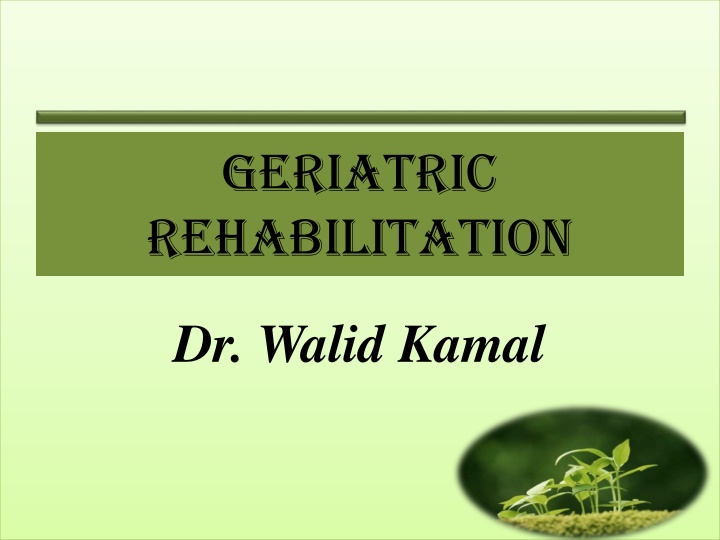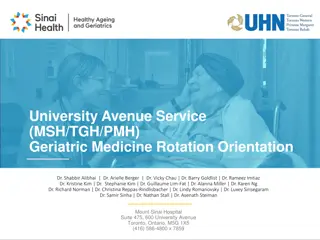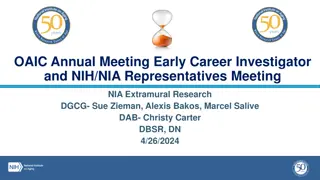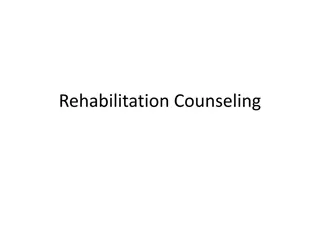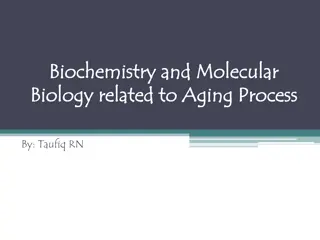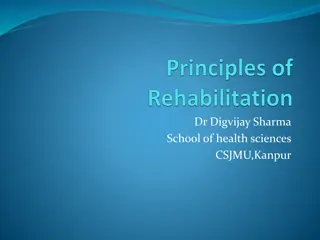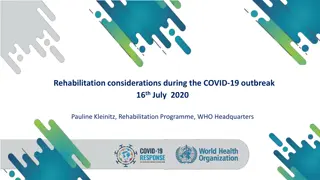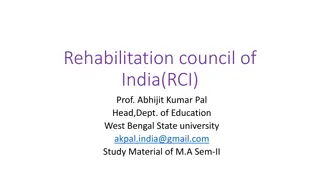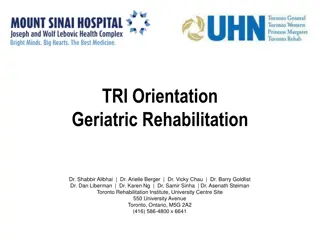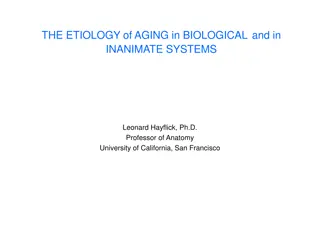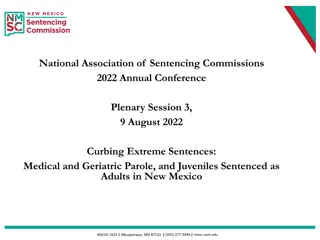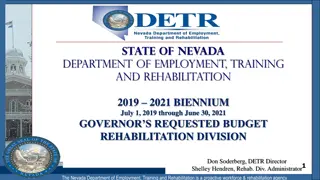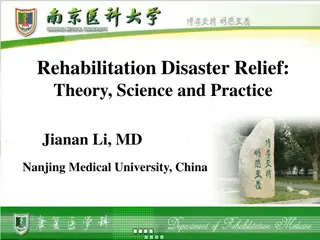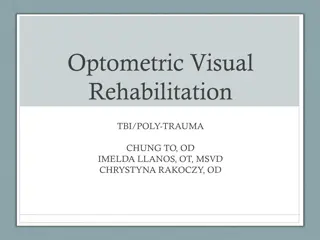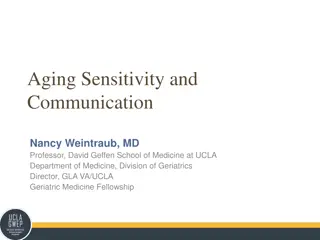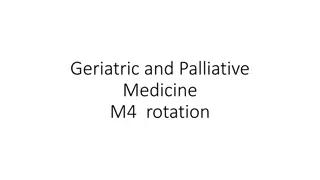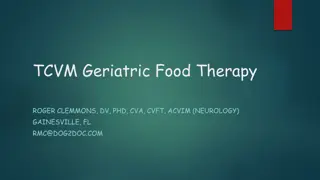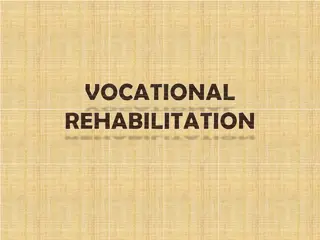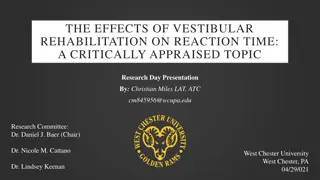Geriatric Rehabilitation and Aging Process
In this resource, Dr. Walid Kamal delves into geriatric rehabilitation and the aging process, covering definitions, common conclusions, theories of aging, and more. Explore the various aspects of aging and how they impact individuals' health and well-being.
Download Presentation

Please find below an Image/Link to download the presentation.
The content on the website is provided AS IS for your information and personal use only. It may not be sold, licensed, or shared on other websites without obtaining consent from the author.If you encounter any issues during the download, it is possible that the publisher has removed the file from their server.
You are allowed to download the files provided on this website for personal or commercial use, subject to the condition that they are used lawfully. All files are the property of their respective owners.
The content on the website is provided AS IS for your information and personal use only. It may not be sold, licensed, or shared on other websites without obtaining consent from the author.
E N D
Presentation Transcript
GERIATRIC REHABILITATION Dr. Walid Kamal
Introduction to the aging process Definitions of aging process: 1. Aging refers to the time-sequential deterioration that occurs including susceptibility to disease, loss of mobility, loss of agility, and age-related physiological changes. 2. Aging is a syndrome of changes that are deleterious, progressive, irreversible. weakness, increased universal and
3. Aging changes occur to molecules (DNA, proteins, lipids), to cells and to organs. Human beings reach a peak of growth and development around the time of their mid 20s. 4. Aging is a predictable process in which gradual changes not caused by disease or accident occur over time. Aging affects both body and mind. Some age-related changes start as early as the 20s; others may not appear until people are in their 70s
N.B Definitions of aging differ between biologists and behavioral scientists. Biologists regard aging as reflecting the sum of multiple and typical biological decrements occurring after sexual maturation. behavioral scientists view it as reflecting regular and expected changes occurring in genetically representative advancing through life cycle under normal environmental conditions. organisms
The common conclusions about aging process showing that the chronological & physiological ages are not always similar. Changes of aging characterized by its universality among all individuals (Everyone will manifest them) at different rates, among and within individuals. Aging changes are progressive (Being slowly, continuous and irreversible) and common to be initiated within the body and not by external reasons. Aging changes has great amount of variability, so it is difficult to separate what is due to aging process versus what is disease process.
Biologic Theories of Aging It refers to anatomical and physiological changes associated with aging, it could be 1. Stochastic Biological theories Aging occurs as a random event and occurs over time. 2. Non-Stochastic Theories ofAging Aging is a pre-determined phenomenon(Non-random event). and timed
Stochastic Biologic Theories of Aging 1- Free radical theory: Free Radicals are produced by aerobic metabolism and by radiation and other environmental agents. So free radicals are highly unstable and reactive molecules that are formed when an electron pair is separated and this makes the molecule highly unstable. When unpaired they start a chain reaction, & look for a partner to make it stable Free radicals disturb DNA and RNA synthesis; interfere with synthesis of protein, which have enzymatic, structural, and control functions, so lower our energy levels, prevent the body from building muscle mass and destroy cellular enzymes, which are needed for vital chemical processes.
Free-radical damage begins at birth and continues until we die. In our youth its effects are relatively minor since the body has extensive repair and replacement mechanisms that in healthy young people function to keep cells and organs in working order. With age however the accumulated effects of free-radical damage begin to take their effect. Free radicals attack collagen and elastin, the substances that keep our skin moist, smooth, flexible and elastic. An age-related accumulation of free-radical damage may be responsible for age related diseases such as hypertension, and osteoarthritis. Substances that prevent the harmful effects of oxidation are known as antioxidants. Natural antioxidants include vitamin C, vitamin E and beta carotene, the substance that our body uses to produce vitaminA.
2- The cross-linking theory of aging The cross-linking theory of aging is based on the observation that with age, our proteins, DNA and other structural molecules develop inappropriate attachments or cross-links to one another. These unnecessary links or bonds decrease the mobility or elasticity of proteins and other molecules. Proteins that are damaged or no longer needed are normally broken down by enzymes called proteases, and the presence of cross-linkages inhibits the activity of proteases. These damaged and unneeded proteins, therefore, stick around and can cause problems.
Collagen is one of the most common proteins found in the skin, tendons, ligaments, bone and cartilage. Each protein is connected to its neighbors by other rungs forming a cross-link. In young people there are few cross-links. The collagen stays soft and pliable. With age however the number of cross-links increases, causing the skin to shrink and become less soft and pliable.
3-The wear and tear theory of aging The wear and tear theory of aging suggests that years of damage to cells, tissues and organs eventually wears them out, killing them and then the body. The damage begins at the level of molecules within our cells. The DNA that makes up our genes sustains repeated damage from ultraviolet light. Our bodies have the capacity to repair DNA damage, but not all of those repairs are accurate or complete. Thus the damage progressively accumulates. toxins, radiation and
4- Waste Accumulation Theory In the course of their life spans cells produce more waste than they can properly eliminate. This waste can include various toxins which when accumulated to a certain level, can interfere with normal cell function, ultimately killing the cell.
5- Mitochondrial Theory Mitochondria are the energy-producing organelles in the cells that are responsible for producing ATP, our primary source of energy. They produce cell energy by a process that leads to the formation of potentially damaging free radicals. Mitochondria are also one of the easiest targets of free-radical injury because they lack most of the defenses found in other parts of the cell.
6- Error (Catastrophe) Theory Over time, errors occur in the transcription of the steps of protein synthesis of RNA & DNA. That error leads to faulty protein synthesis & aging or impaired cell function & death. The reproduced cells don t resemble the original cells and function diminished No enough support with the recent research about this theory. According to the theory no much we can do but to try and alter factors that may cause mutation of DNA and RNA such as radiation, poor nutrition, exposure to sun and pollution.
Non Stochastic Biologic Theories of Aging 1- Hay flick Limit Theory The aging process is under control of a biological clock contained within each living cell. The human fibroblast cells (lung, skin, muscle, heart) have a limited life span. They divided approximately 50 times over a period of years and then suddenly stopped. Nutrition seemed to have an effect on the rate of cell division: overfed cells made up to 50 divisions in a year, while underfed cells took up to three times as long as normal cells to make divisions. Alterations and degenerations occurred within some cells before they reached their growth limit. This improper functioning of cells and loss of cells in organs & tissues may be responsible for effects of aging.
2- The Genetic Control Theory This theory focuses on the genetic programming encoded within our DNA. We are born with a unique genetic code, a predetermined tendency to certain types of physical and mental functioning, and that genetic inheritance has a great deal to say about how quickly we age and how long we live. Each of us has a biological clock set to go off at a particular time. When that clock goes off it signals our bodies first to age & then to die.
3- The Neuroendocrine Theory This theory focused on the neuroendocrine system, the complicated network of biochemical that governs the release of our hormones and other vital bodily elements. When we are young, our hormones work together to regulate many bodily functions. Different organs release various hormones all under the governance of the hypothalamus, which is located within the brain. The hypothalamus responds to the body's hormone levels as its guide to regulating hormonal activity. Hormones are vital for repairing and regulating our bodily functions, and when aging causes a drop in hormone production, it causes a decline in our body's ability to repair and regulate itself as well
4-Autoimmune Theory Immune system made up of T and B cells. T cells are responsible for cell-mediated differentiates self from non-self. T cells circulate in blood and lymph system. B cells are residing in lymph nodes produce and secrete antibodies into the body based on messages from T cells. The Primary function of immune system is to differentiate self from non-self. With an older individual that function of T and B cells get depressed, and no longer able to recognize between one s own structures & foreign structures leading to increased infection, cancer & autoimmune diseases. immunity which
5- Thymic-Stimulating Theory The theory focused on the thymus as the master gland of the immune systems. The size of this gland reduces from 200 to 250 grams at birth and then shrinks to around three grams by age 60. Scientists are investigating whether the disappearance of the thymus contributes to the aging process by weakening the body's immune system. Thymic hormones may also play a role in stimulating and controlling the production of neurotransmitters and brain and endocrine system hormones which means they may be the pacemakers of aging itself, as well as key regulators responsible for immunity.
Psychosocial Theories of Aging 1-Activity Theory Activity adds to life satisfaction. Declining the physical activity allows activities. As roles change, the individual finds substitute activities for these roles. Life satisfaction in old age depends on being active (Having many roles and maintaining middle age roles and life styles as long as possible. development of other
2- Disengagement Theory Based on benefits of older adults mutual withdrawal and need for social equilibrium. That situation occurs with retirement and loss of spouse. Physical and psychological distress results, which is not a norm.
3- Continuity Theory This theory was developed because the other 2 theories didn t satisfactorily explain social roles and aging. The best indicator of how a person will age can be determined by the manner in which they lived their lives and how they have adapted and coped with changes and stress. How a person lived their life is likely to continue as one ages. Old age is an integral part of the life cycle or pattern of our lives. The aging person continues to maintain his / her typical way of adapting to the environment. With age, we only become as more as what we were in earlier life.
4- Role Theory: Society expects individuals to take certain role, and give up certain roles, at certain times in life. There is parallel between chronological expectations. As in school age, retirement age the timing of many events is prescribed by social norms. The norms change with time and vary depending on factors such as culture, Flexibility of norms as early marriage individuals tends to see them old faster. age and social socioeconomic status.
5- Developmental Tasks of Aging Successful achievement leads to happiness, growth, and success with later tasks. While failure leads to unhappiness, disapproval by society and difficulty with later tasks. So, elderly persons are going through adjusting to decreasing physical strength, health adjusting to retirement, reduced income, meeting social obligations, establishing satisfactory living arrangements and adjusting to death of spouse.
Importance of studying aging theories 1. Achance for thinking & guidelines for aging process. 2. New opportunities for further research by suggesting testable predictions and we benefit from this. 3. Theoretical framework that may allow everyone of us to handle an enormous amount of diverse observations related to aging phenomena. 4. Knowing cause(s) of aging, because as with treating any disease one must first understand the problem, so that afterward the precise remedy can be applied. 5. Increases our awareness about aging process.
6. It indicates for us meaning of some terms ignored for us as the meaning of biological clock 7. It gives us an alternative view for looking at aging. 8. Understand the wide diversity of human thoughts, feelings and behavior concerning aging. 9. Theories make us be aware of many things lead to aging and we use every day in our house and we do not care about them as the simple thing in our houses which is cooking in the aluminum. 10. Theories indicate for us the benefits of taking vitamins as vitamin C and vitamin D for good health and for delaying aging.
